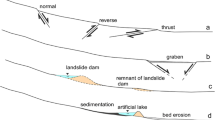Abstract
Initiation and recession of the knickpoints are significant boundary condition for processes of fluvial system. The distribution and recession rates of knickpoints contain information that provides a fundamental understanding of geomorphic processes. In the Yalu River-Wangtian’e volcanic region of northeastern China, broadly distributed flat lava terrain provides an ideal site to study the recession of fluvial knickpoints because knickpoints and waterfalls are well preserved here. Here we describe the distribution of knickpoints in the Yalu River-Wangtian’e volcanic region by combining DEM analysis and numerical modeling. Furthermore, we present a knickpoint celerity model, derived from stream-power incision model, to relate knickpoint recession rate to drainage area. We calibrate important empirical coefficients with our knickpoint celerity model; the best fit erosion coefficient (K) is 1.32×10−8, and the best fit drainage area exponent (m) is 0.69. Error analysis indicates a close correspondence between synthetic and real knickpoints. Finally, we show that knickpoint recession rates in the Yalu River-Wangtian’e volcanic region are ∼1–10 mm/a during the early stages of transient incision, and that the present rates are ∼1–6 mm/a. Our recession rate results are in good agreement with previous findings from the Aso Volcano and volcanoes near Boso Peninsula (Japan), which have a similar geologic history to the Yalu River-Wangtian’e volcanic region. Our present effort provides new insight into landscape evolution in the Yalu River-Wangtian’e volcanic region in northeastern China.
Similar content being viewed by others
References
Whipple K X. Bedrock rivers and the geomorphology of active orogens. Annu Rev Earth Planet Sci, 2004, 32: 151–185
Gardner W. Experimental study of knickpoint and longitudinal profile evolution in cohesive, homogeneous material. Geol Soc Am Bull, 1983, 94: 664–672
Crosby B T, Whipple K X. Knickpoints in the Waipaoa River, North Island, New Zealand. Geomorphology, 2006, 82: 16–38
Bishop P, Hoey T B, Jansen J D, et al. Knickpoint recession rate and catchment area: The case of uplifted rivers in eastern Scotland. Earth Surf Proc Land, 2005, 30: 767–778. doi: 10.1002/esp.1191
Zhang H P, Zhang P Z, Wu Q L, et al. Characteristics of the Huanghe River longitudinal profiles around Xunhua-Guide area (NE Tibet) and their tectonic significance (in Chinese). Quat Sci, 2008, 28: 229–309
Wallace R E. Degradation of the Hebgen Lake fault scarps of 1959. Geology, 1980, 8: 225–229
Harkins N, Kirby E, Heimsath A, et al. Transient fluvial incision in the headwaters of the Yellow River, northeastern Tibet, China. J Geophys Res, 2007, 112, doi: 10. doi: 10.1029/2006JF000570
Hayakawa Y, Matsukura Y. Recession rates of waterfalls in Boso Peninsula, Japan, and a predictive equation. Earth Surf Proc Land, 2003, 28: 675–684
Hayakawa Y, Yokoyama S, Matsukura Y. Erosion rates of waterfalls in post-volcanic fluvial systems around Aso volcano, southwestern Japan. Earth Surf Proc Land, 2008, 33: 801–812
Fan Q C, Liu R X, Zhang G H, et al. The genesis and evolution of bimodal volcanic rocks in Wangtian’e Volcano, Changbaishan (in Chinese). Acta Petrol Sin, 1998, 14: 305–317
Liu R X, Fan Q C, Zheng X S, et al. The magma evolution of Tianchi volcano, Changbaishan. Sci China Ser D-Earth Sci, 1998, 41: 382–389
Fu B H, Yoshiki N, Dong Y F, et al. Generation of 3-Dimensional perspective satellite imagery and its application on Quaternary geomophological analysis (in Chinese). Quat Sci, 2008, 28: 189–196
Wang Y, Li C, Wei H, et al. Late Pliocene-recent tectonic setting for the Tianchi volcanic zone, Changbai Mountains, northeast China. J Asian Earth Sci, 2003, 21: 1159–1170
Fan Q C, Sui J L, Wang T H, et al. History of volcanic activity, magma evolution and eruptive mechanisms of the Changbai volcanic province (in Chinese). Geol J China Univ, 2007, 13: 175–190
Whipple K X, Tucker G E. Dynamics of the stream power river incision model: Implications for height limits of mountain ranges, landscape response time scales and research needs. J Geophys Res, 1999, 104: 17661–17674
Chen Y J, Song G C, Chen Z N. Stream power incision model of the non-steady state orogen (in Chinese). Chin Sci Bull, 2006, 51: 7865–869
Duvall A, Kirby E, Burbank D. Tectonic and lithologic controls on bedrock channel profiles and processes in coastal California. J Geophys Res, 2004, 109, doi: 10. doi: 10.1029/2003JF000086
Whipple K X, Hancock G S, Anderson R S. River incision into bedrock: Mechanics and relative efficacy of plucking, abrasion, and cavitation. Geol Soc Am Bull, 2000, 112: 490–503
Berlin M M, Anderson R S. Modeling of knickpoint retreat on the Roan Plateau, western Colorado. J Geophys Res, 2007, 112: F03S06, doi: 10. doi: 10.1029/2006JF000553
Whipple K X. Fluvial landscape response time: How plausible is steady state denudation? Am J Sci, 2001, 301: 313–325
Snyder N P, Whipple K X, Tucker G E, et al. Landscape response to tectonic forcing: DEM analysis of stream profiles in the Mendocino triple junction region, northern California. Geol Soc Am Bull, 2000, 112: 1250–1263
Crosby B T, Whipple K X, Gasparini N M, et al. Formation of fluvial hanging valleys: Theory and simulation. J Geophys Res, 2007, 112: F03S10, doi: 10. doi: 10.1029/2006JF000566
Wobus C W, Crosby B T, Whipple K X. Hanging valleys in fluvial systems: Controls on occurrence and implications for landscape evolution. J Geophys Res, 2006, 111, F2, F02017, doi: 10.1029/2005JF000406
Goode J K, Burbank D W. Numerical study of degradation of fluvial hanging valleys due to climate change. J Geophys Res, 2009, 114: F01017, doi: 10.1029/2007JF000965
Author information
Authors and Affiliations
Corresponding author
Rights and permissions
About this article
Cite this article
Zhang, H., Zhang, P. & Fan, Q. Initiation and recession of the fluvial knickpoints: A case study from the Yalu River-Wangtian’e volcanic region, northeastern China. Sci. China Earth Sci. 54, 1746–1753 (2011). https://doi.org/10.1007/s11430-011-4254-6
Received:
Accepted:
Published:
Issue Date:
DOI: https://doi.org/10.1007/s11430-011-4254-6




